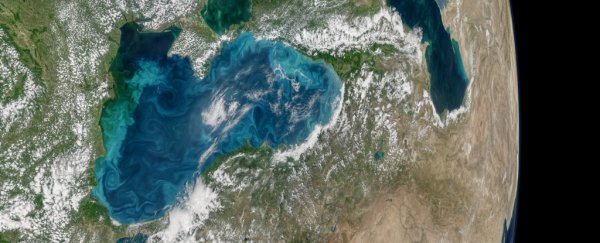Scientists call them 'dead zones': vast expanses of ocean water that contain little or no oxygen, making it almost impossible for many marine life-forms to survive within them.
These giant ecological hazards – which have dramatically expanded in both number and volume in recent decades – are now extending beyond the sea into freshwater sources on land, and according to a new study, we may have underestimated the size of the problem.
The conventional view on dead zones (aka oxygen minimum zones [OMZs] and sometimes also called 'shadow zones') is that their hypoxic conditions are produced when excess nutrient pollution from human activities flows into coastal waters, encouraging the growth of algae blooms, which in turn decompose into organic material that sinks to the seafloor.
As that organic material slowly plummets into the abyss, it attracts and consumes oxygen in a process that deprives marine life of the same vital resource.
This overall process is viewed as the primary cause of dead zones, but there could be another important factor behind the problem that we've overlooked until now, according to an international team of researchers led by biogeochemist Sabine Lengger from the University of Plymouth, UK.
"Our study shows that organic matter that sinks to the seafloor is not just coming from the sea surface, but includes a major contribution from bacteria that live in the dark ocean and can fix carbon as well," Lengger says.
"Existing models could be missing out on a key contribution as a result of which people have underestimated the extent of the oxygen depletion we are to expect in a future, warming world."
According to the researchers, who analysed sediment cores extracted from the floor of the Arabian Sea – the site of what is thought to be the largest dead zone in the world – anaerobic bacteria that dwell in deep waters could be responsible for producing almost one-fifth of the organic matter that exists on the seabed.
The implications, the team says, is that current models don't take this factor, called 'dark carbon fixation', into account when they attempt to simulate and predict how dead zones may evolve in the future – meaning we've been missing a pretty big piece of the dead zone puzzle.
"Biogeochemical models that operate on the assumption that all sinking organic matter is photosynthetically derived, without new addition of carbon, could significantly underestimate the extent of remineralisation," the authors write in their paper.
"Oxygen demand in oxygen minimum zones could thus be higher than projections suggest, leading to a more intense expansion of OMZs than expected."
The findings come only days after the release of a stark scientific report published by the International Union for Conservation of Nature (IUCN), which concluded dead zones are spreading like an oceanic plague, numbering around 700 today, whereas less than 50 had been identified in the 1960s.
Hopefully these new findings give us a better way of identifying the true extent of this troubling phenomenon, so that we can do something about it before it's too late.
The findings are reported in Global Biogeochemical Cycles.
